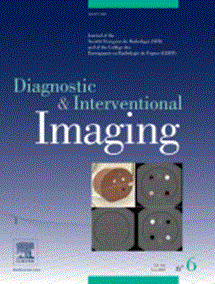Assessment of small bowel ischemia in mechanical small bowel obstruction: Diagnostic value of bowel wall iodine concentration using dual-energy CT
IF 8.1
2区 医学
Q1 RADIOLOGY, NUCLEAR MEDICINE & MEDICAL IMAGING
引用次数: 0
Abstract
Purpose
The purpose of this study was to determine whether dual-energy computed tomography (DECT), specifically by measuring bowel wall iodine concentration (BWIC), is superior to monoenergetic reconstructions (MR) for the diagnosis and staging of small bowel ischemia in patients with mechanical small bowel obstruction (SBO).
Materials and methods
From November 2021 to December 2023, all patients with mechanical SBO who underwent contrast-enhanced DECT of the abdomen and pelvis were evaluated for inclusion. Demographic, clinical and biochemical data were collected. Two abdominal radiologists, blinded to all patient information, reviewed all DECT examinations. Conventional CT features (including a closed loop mechanism, mesenteric haziness, decreased bowel wall enhancement (DBE), and increased unenhanced attenuation of the bowel wall) were first reviewed on 70-keV-MR and 40-keV-MR, followed by BWIC measurements in five regions of interest in the walls of both normal and abnormal small bowel loops. The diagnostic performance of a simple CT score, which included a closed loop mechanism, mesenteric haziness and DBE, was compared to that of BWIC measurements made on dilated and/or abnormal small bowel segments for the diagnosis of small bowel ischemia. The diagnostic capabilities were compared using areas under the receiver operating characteristic curves (AUCs).
Results
A total of 142 patients were included (80 men, 62 women; mean age, 67 ± 17 [standard deviation (SD)] years). Fifty-six patients underwent surgery; 22 of them had confirmed small bowel ischemia, including 12 patients with small bowel necrosis requiring surgical resection. Significant differences in mean BWIC were found between patients without small bowel ischemia (1.73 ± 0.44 [SD] mg/mL), those with small bowel ischemia without necrosis (0.79 ± 0.37 [SD] mg/mL), and those with small bowel ischemia and necrosis (0.48 ± 0.32 [SD] mg/mL) (P < 0.001). The overall AUC of the BWIC measurement for diagnosing small bowel ischemia was 0.98 (95 % confidence interval [CI]: 0.97–1.00), similar to the AUC of the simple CT score (0.97; 95 % CI: 0.92–1.00). However, using a cut off-value of 1.16 mgI/mL, BWIC outperformed subjective assessment of DBE at 70-keV-MR and 40-keV-MR (Youden index, 0.90 vs. 0.54 and vs. 0.71, respectively) (P < 0.001 for both).
Conclusion
BWIC measurement outperforms subjective assessment of DBE for the diagnosis of small bowel ischemia in patients with SBO and can allow stratification of ischemia. However, BWIC does not outperfomr a global comprehensive analysis of conventional CT images.
机械性小肠梗阻的小肠缺血评估:使用双能 CT 对肠壁碘浓度的诊断价值。
目的:本研究旨在确定双能计算机断层扫描(DECT),特别是通过测量肠壁碘浓度(BWIC),在机械性小肠梗阻(SBO)患者小肠缺血的诊断和分期方面是否优于单能重建(MR):从 2021 年 11 月至 2023 年 12 月,对所有接受过腹部和盆腔造影剂增强 DECT 的机械性 SBO 患者进行评估。收集人口统计学、临床和生化数据。两名腹部放射科医生对所有患者信息进行盲检,并对所有 DECT 检查进行复查。首先在 70-keV-MR 和 40-keV-MR 上检查常规 CT 特征(包括闭襻机制、肠系膜混浊、肠壁增强(DBE)减弱和肠壁未增强衰减增加),然后在正常和异常小肠襻肠壁的五个感兴趣区测量 BWIC。在诊断小肠缺血方面,比较了简单 CT 评分(包括闭环机制、肠系膜混浊和 DBE)与扩张和/或异常小肠节段 BWIC 测量的诊断性能。结果:共纳入 142 名患者(男性 80 人,女性 62 人;平均年龄 67 ± 17 [标准差 (SD)] 岁)。56名患者接受了手术,其中22人确诊为小肠缺血,包括12名需要手术切除的小肠坏死患者。未发现小肠缺血的患者(1.73 ± 0.44 [SD] mg/mL)、小肠缺血但无坏死的患者(0.79 ± 0.37 [SD] mg/mL)和小肠缺血且有坏死的患者(0.48 ± 0.32 [SD] mg/mL)之间的平均 BWIC 存在显著差异(P < 0.001)。诊断小肠缺血的 BWIC 测量的总体 AUC 为 0.98(95 % 置信区间 [CI]:0.97-1.00),与简单 CT 评分的 AUC(0.97;95 % CI:0.92-1.00)相似。然而,在 70-keV-MR 和 40-keV-MR 条件下,以 1.16 mgI/mL 为临界值,BWIC 的测量结果优于 DBE 的主观评估结果(Youden 指数分别为 0.90 vs. 0.54 和 0.71)(P < 0.001):结论:在诊断 SBO 患者小肠缺血方面,BWIC 测量优于 DBE 的主观评估,并可对缺血进行分层。结论:在诊断 SBO 患者小肠缺血方面,BWIC 测量结果优于 DBE 主观评估结果,并能对缺血情况进行分层。
本文章由计算机程序翻译,如有差异,请以英文原文为准。
求助全文
约1分钟内获得全文
求助全文
来源期刊

Diagnostic and Interventional Imaging
Medicine-Radiology, Nuclear Medicine and Imaging
CiteScore
8.50
自引率
29.10%
发文量
126
审稿时长
11 days
期刊介绍:
Diagnostic and Interventional Imaging accepts publications originating from any part of the world based only on their scientific merit. The Journal focuses on illustrated articles with great iconographic topics and aims at aiding sharpening clinical decision-making skills as well as following high research topics. All articles are published in English.
Diagnostic and Interventional Imaging publishes editorials, technical notes, letters, original and review articles on abdominal, breast, cancer, cardiac, emergency, forensic medicine, head and neck, musculoskeletal, gastrointestinal, genitourinary, interventional, obstetric, pediatric, thoracic and vascular imaging, neuroradiology, nuclear medicine, as well as contrast material, computer developments, health policies and practice, and medical physics relevant to imaging.
 求助内容:
求助内容: 应助结果提醒方式:
应助结果提醒方式:


